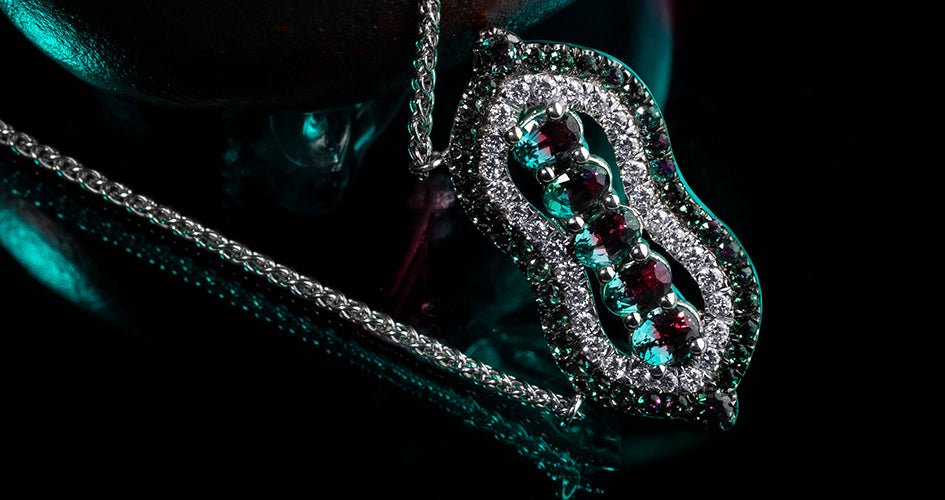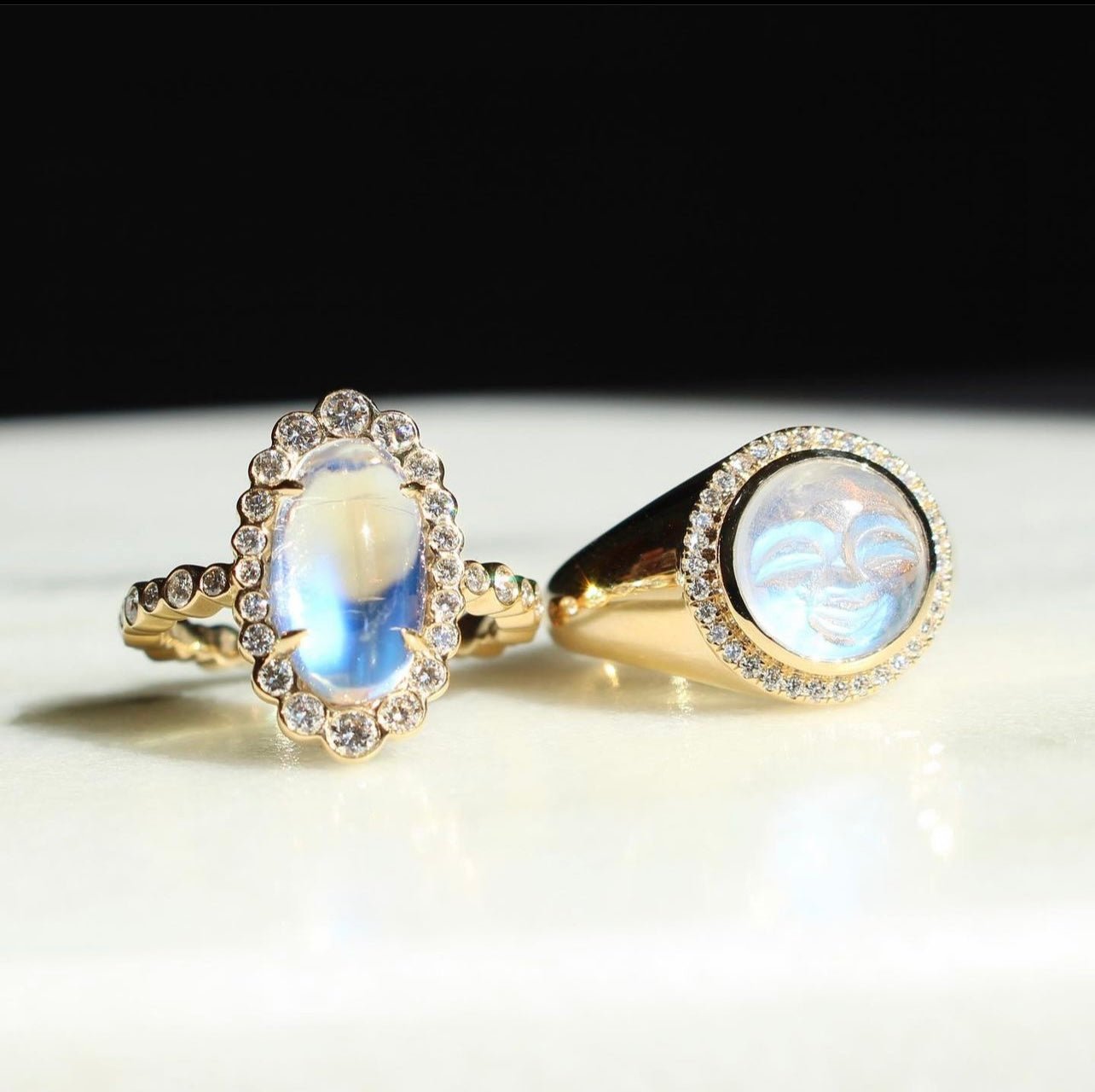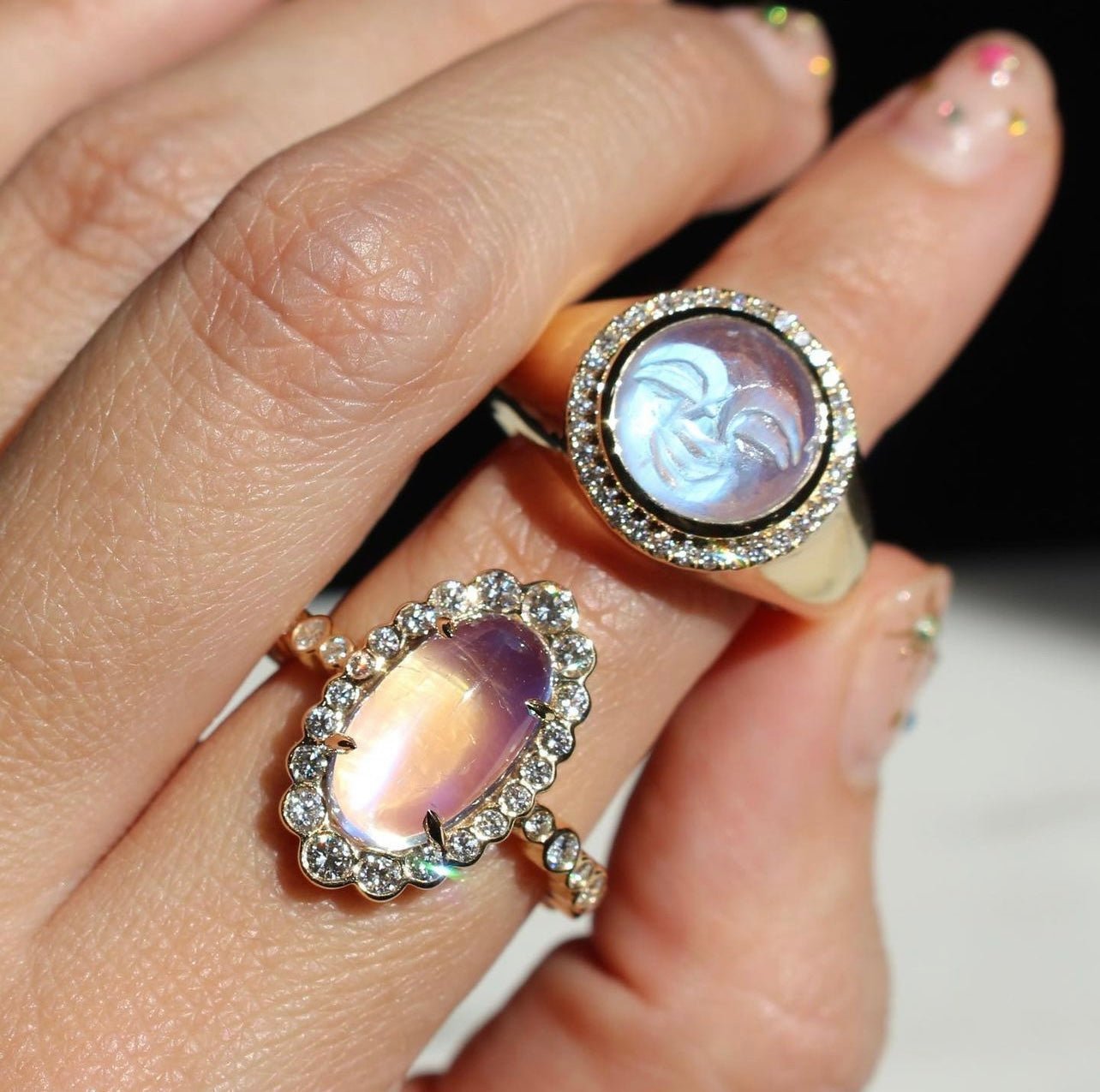You may have marveled at the beauty of a diamond ring or wondered how a piece of turquoise could display such ravishing blues and yellows. Maybe you even pondered what it would look like if the shine and sparkle of the former met the multi-colored beauty of the latter.
If you’ve ever dreamed up a color-changing, pleochroic gem, we are here to tell you that your dream is far from a false reality - and it can be found in alexandrite.
Exotic gems are incredible alternatives to the mundanity that can come with the Big Three options in jewelry: emeralds, diamonds, and rubies. Despite what you may have been told regarding the rarity of these stones, they are harvested in large quantities and crop up throughout the world. This allows for immensely accessible supplies and commonplace use in jewelry.
True rarity comes in the form of unique gems. Looking for something truly unique? The Alexandrite Effect is the namesake of alexandrite due to its ability to transition from a green hue in daylight to a stunning red under incandescent light.
We specialize in alexandrite cultivation, production, and sale here at Mark Henry Jewelry. With over three decades of experience, we are well-versed in the exotic gem world. Here is our explanation from a gemstone artisan on the color-changing properties of alexandrite. Allow us to bring you into our world as we examine the complexities of a one-of-a-kind gemstone.
Origins and Omens
Alexandrite was first discovered in the Ural Mountains of Russia in 1834. Finnish mineralogist, Nils Gustaf Nordenskiöld, was leading an expedition when one of his workers struck what they believed to be a piece of emerald. This was not surprising since they were mining an area in close proximity to an emerald mine.
However, as day became night, the gorgeous green of the stone transformed into a shocking red hue. Nordenskiöld realized that he had stumbled upon something inherently rare.
Count Lev Alekseevich Perovskii chose to name the gem in honor of Czar Alexander II. Czar Alexander II was soon to become the leader of Imperial Russia (where the colors of the flag ironically matched those of the stone). Alexandrite had become so popular in the region, likely due to the influence of the Russian leaders, that its supply was nearly entirely gone by the 1890s. All hope seemed lost for such a priceless gem.

Internationally-Renowned
Thankfully, in 1987, the color-changing wonder was found in Brazil. That same decade, it was struck in Sri Lanka and Africa. Over the years, it has cropped up in a few, special locations including the likes of Zimbabwe. It is important to note that the colors of alexandrite vary depending on where the gem was mined.
Metrics of Value
Value is determined mostly by the percentage of color change since it can vary from one percent to 100 percent. While other gems are ranked by their clarity or hardness, alexandrite’s saturation only falls second to how strongly it switches hues.
A piece of alexandrite that is completely translucent and perfect for jewelry cuts but fails to show a complete color change under different kinds of lighting is inherently less valuable. The jewelry world would rather have a grainy and opaque alexandrite but has a higher color change percentage.
Since saturation is a factor in value, Brazilian alexandrite is the rarest and favored - right behind what is left in the circulation of the Russian supply. While it is true that Brazilian colors can be paler, they are also known to be ultra-fine due to large amounts of gallium and aluminum in the mines.
They are the brightest and sharpest color contrasts available, which is why we are so proud to share that our entire alexandrite supply comes from a family-owned mine in Brazil. This is reflected in the impeccable quality of our collection.
Other findings, like Sri Lankan alexandrite, can have a deep olive tone under daylight and/or sunlight. Alexandrite found in Zimbabwe has the classic emerald hues in the day but tends to be much smaller than findings in other locations.
Basic Properties
Apart from the Alexandrite Effect, the other broad components of this gem should be noted for a better understanding of how it functions. Here are some of its key elements:
- Luster: Vitreous.
- Hardness: 8.5 on the Mohs Scale (incredibly wearable and versatile in placement).
- Birefringence: 0.009-0.010.
- Heat Sensitivity: Exists.
- Luminescence: Weak in red Short and Long Waves, but still present.
- Transparency: Ranges from opaque to transparent.
- Pleochroism: Varies from red/orange to yellow/green.
Typically, alexandrite occurs in gneiss, mica schist, dolomitic marbles, stream pebbles, grains, and pegmatites. It is formed through a combination of beryllium and chromium, which adds to its rarity since these elements do not usually concur in the same rocks. An extra layer of magic.
Additional phenomena to the gem itself include chatoyancy, the “cat’s eye” effect that can order in chrysoberyls. Since alexandrite is in the chrysoberyl family, it is possible for this to present itself in some gems, but it is still quite rare and can raise the value significantly depending on what the buyer is looking for.

A Scientific Understanding
With the basics outlined, it’s time to get into the specifics about what makes the Alexandrite Effect operate. Of course, various studies have been done to further understand this puzzling yet entrancing effect. Those that deep-dive into this topic first explore the fact that the effect did not always occur between ambient lighting and incandescent lighting - alexandrite was found in the early 1800s, several decades before the invention of the lightbulb.
The incandescent illumination was actually originally given off by candlelight rather than an electrical factor, yet the color change remains constant over 200 years of technological advancements.
The change in colors boils down to the impure parts of chromium that are included in the atomic structure of alexandrite. These get absorbed in the visible light spectrum under the yellow section’s band, also known simply as yellow light. The stone also throws around blue, red, and green light, which can change in amounts due to the type of light source.
It has been found that the amount of green compared to the number of red stimuli under a variety of lights produces the biggest change in alexandrite (compared to other objects). This effect is what sets apart the gem’s color change and the way that we perceive it. It is also similar to the optical phenomenon that had the whole world fighting over what color The Dress was in 2016.
The difference between this dress and alexandrite is that the green and red hues in alexandrite appear the same to everyone for a very particular reason. The colors in alexandrite look the same to everyone because the color angles are above 20 degrees. The angle is in safe enough territory to solidify its colors for everyone.
The Quick Change
It has been concluded that the Alexandrite Effect has more to do with how our eyes adjust to different luminescence and not a chemical reaction or spontaneous change when lights come on or off. It is known that human optics have a higher sensitivity to green light than red or blue light.
This is why we grab onto the green hues when it is daylight or when in more natural lighting. Incandescent lighting has a lower color temperature and tends to have more blue undertones, bringing out the red in the gem to our vision.
The major takeaway of studies done on the Alexandrite Effect is that the original beliefs of the color-changing phenomenon were not too far from reality, even with quite limited scientific methods and tools at the time.
Chromium has a 0.18-mole percent concentration in gems that had little to no color change effect but a 0.64-mole percent concentration in those that clearly do. Once again, all signs point to chromium content in determining how strong an alexandrite’s color change will be.
It does raise questions regarding other chromium-inclusive minerals and why they don’t have similar optical effects. The answer? Maybe alexandrite really is magic.
Everyday Magic
Mark Henry Jewelry’s rich history ethically sourcing alexandrite since 2004 from a family-run Brazilian mine has led to a complex and deep appreciation for the Alexandrite Effect throughout all of our work. Alexandrite itself is known to symbolize fulfillment, a zest for adventure, connection, and even love. That is why we try to feature it in as many collections as possible, hoping to share these values with our customers in everything from rings to necklaces.
We are involved in every step of the mining and production process of our alexandrite, and transparency is key. We understand the importance of preserving these precious gems and their supply, which is why we use the most sustainable methods with small businesses in an effort to reduce waste and make the most of our own findings. Our alexandrite is of the highest quality and has the most valuable, intense color changes one can find in exotic gem communities.
Alexandrite may be rare, but being unique is timeless.
Sources:
Explanation of the Colour Change in Alexandrites | Nature
Alexandrite Value, Price, and Jewelry Information | Gem Society



Hi hello sir I called you send me your contact number